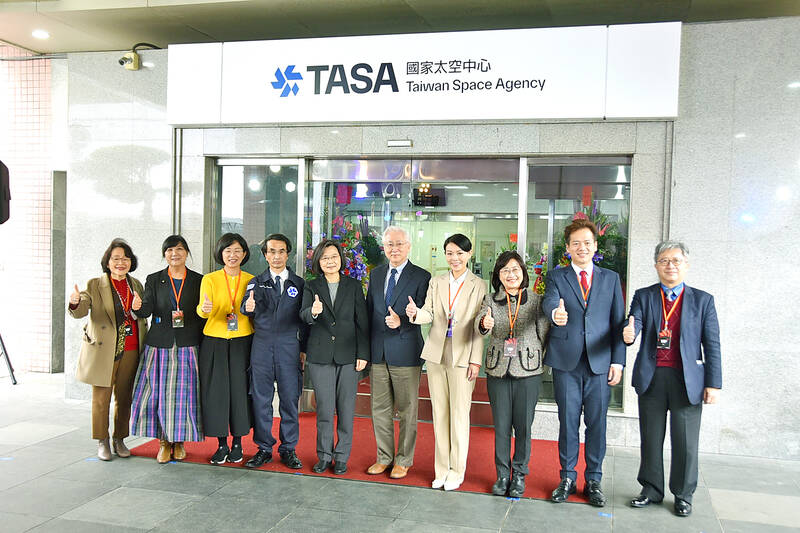The national space agency yesterday officially changed its name to the Taiwan Space Agency (TASA), after it was earlier this week upgraded and placed under the purview of the Cabinet-level National Science and Technology Council.
The Hsinchu City-based entity, previously called the National Space Organization, was renamed to include “Taiwan,” as this would improve readability and international recognition, the council said.
“The reorganization is a very important milestone for the country’s space development” as domestic technology would now receive more international recognition, President Tsai Ing-wen (蔡英文) said at the rebranding ceremony.

Photo: Wu Po-hsuan, Taipei Times
She said after the reorganization, TASA would be tasked with additional assignments, such as working with the Ministry of Economic Affairs to upgrade the nation’s space industry and working with the Ministry of Education to train space industry talent.
To seize international business opportunities, “we have been preparing to install ourselves in space. Taiwan’s 30 years of development of space technology and its accumulated results in the research and development of satellites have given it an excellent track record,” Tsai said.
TASA Director-General Wu Jong-shinn (吳宗信) told reporters that the reorganization would give the agency access to additional resources.
Taiwan’s advantage in space development is that it has the necessary fundamentals and has reached the stage at which is develops its own components, Wu said.
TASA, which currently employs about 200 people, is planning to recruit about 300 new staff over the next three years, Wu added.
“The restructuring also allows for a raise in salaries, which will be more attractive compared with the past,” he said.
The restructuring was implemented on Jan. 1 in accordance with the Act for the Establishment of the Taiwan Space Agency (國家太空中心設置條例), which was promulgated on May 4 last year.
The upgraded status aims to enhance national space technology research and development capabilities, implement national space strategies and plans, and promote the development of space activities and the space industry, the act says.
Originally established in 1991 as the National Space Program Office of the National Space Technology Long-Term Development Program, the entity became part of the National Applied Research Laboratories in 2003 and renamed the National Space Organization in 2005.
Since 1999, the agency has seen the launch of the Formosat-1, Formosat-2, Formosat-3, Formosat-5 and Formosat-7 satellites.
The Formosat-5 and Formosat-7 constellations are still in service, while Formosat-8, a constellation of six high-resolution optical remote sensing satellites, is to be launched next year and in 2025.
The TRITON (Wind-Hunter Satellite) is to be launched this year as part of an effort to research air-sea interaction and predict the intensity of typhoons, Wu said.
“Through a GPS receiver we can measure the height of the waves in the sea and calculate the speed of the wind, which is very important for our daily weather predictions,” Wu said.

Taiwan is to commence mass production of the Tien Kung (天弓, “Sky Bow”) III, IV and V missiles by the second quarter of this year if the legislature approves the government’s NT$1.25 trillion (US$39.78 billion) special defense budget, an official said yesterday. Commenting on condition of anonymity, a defense official with knowledge of the matter said that the advanced systems are expected to provide crucial capabilities against ballistic and cruise missiles for the proposed “T-Dome,” an advanced, multi-layered air defense network. The Tien Kung III is an air defense missile with a maximum interception altitude of 35km. The Tien Kung IV and V

The disruption of 941 flights in and out of Taiwan due to China’s large-scale military exercises was no accident, but rather the result of a “quasi-blockade” used to simulate creating the air and sea routes needed for an amphibious landing, a military expert said. The disruptions occurred on Tuesday and lasted about 10 hours as China conducted live-fire drills in the Taiwan Strait. The Civil Aviation Administration (CAA) said the exercises affected 857 international flights and 84 domestic flights, affecting more than 100,000 travelers. Su Tzu-yun (蘇紫雲), a research fellow at the government-sponsored Institute for National Defense and Security Research, said the air

Taiwan lacks effective and cost-efficient armaments to intercept rockets, making the planned “T-Dome” interception system necessary, two experts said on Tuesday. The concerns were raised after China’s military fired two waves of rockets during live-fire drills around Taiwan on Tuesday, part of two-day exercises code-named “Justice Mission 2025.” The first wave involved 17 rockets launched at 9am from Pingtan in China’s Fujian Province, according to Lieutenant General Hsieh Jih-sheng (謝日升) of the Office of the Deputy Chief of the General Staff for Intelligence at the Ministry of National Defense. Those rockets landed 70 nautical miles (129.6km) northeast of Keelung without flying over Taiwan,

A strong continental cold air mass is to bring pollutants to Taiwan from tomorrow, the Ministry of Environment said today, as it issued an “orange” air quality alert for most of the country. All of Taiwan except for Hualien and Taitung counties is to be under an “orange” air quality alert tomorrow, indicating air quality that is unhealthy for sensitive groups. In China, areas from Shandong to Shanghai have been enveloped in haze since Saturday, the ministry said in a news release. Yesterday, hourly concentrations of PM2.5 in these areas ranged from 65 to 160 micrograms per cubic meter (mg/m³), and pollutants were